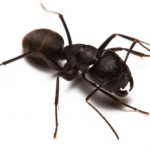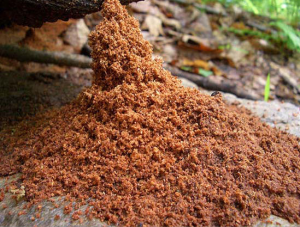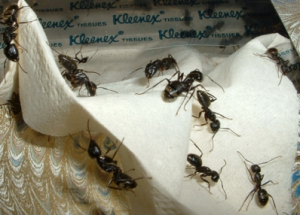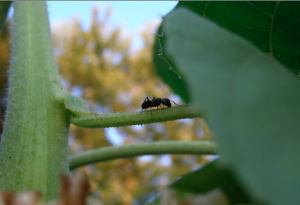It’s a shame that where I live now we really don’t have a huge carpenter ant problem. Not to say that we don’t have them around, we do and at times a home in the south east can be over run. In Florida however the carpenter ant is not as destructive nor as much of a challenge as they can be in the more northern states. Most of my work and experience for this ant came from Maryland and on the Pacific west coast.
Carpenter ants are some of the largest we have to deal with and their complex colony structure can frustrate a homeowner who thinks that they have found and destroyed THE nest only to be disappointed when the activity resumes or never goes away. To rid a structure of this wood destroying insect you’ll need to be armed with the knowledge of how they operate and what their needs are or you may be in for a long losing battle.
Foragers are the main culprit that most people see. These ants are usually the older more expendable ants in the colony so killing a trail of them really does no damage to the colony. Searching for food is a dangerous job and this species of ant chooses to send out those that are past their usefulness inside the nest and may die soon anyway. When we think of trailing ants we picture long orderly lines trailing along but the carpenter ant is not so obvious. Their trails can go underground, pop up along a fence line, across a wire and up the downspout and seem to make no sense. While they do use pheromones for others to follow, at times they can be so scattered across a yard that no established trail is obvious. Night time is the best time to look for active ants and they peak rather late so get ready to lose an hour or two of sleep if you go looking. Following a forager takes a long time and with their winding trails you may not be sure if they’re coming or going. It’s best to find one that has found food and is carrying it back to the nest to save time. You can attempt to bait the ants ahead of time and this can work but the carpenter ants are finicky and may show no interest in your free food at all. Cut up crickets work the best (I’ve found) to entice them to take the bait and head back to the nest.
colony so killing a trail of them really does no damage to the colony. Searching for food is a dangerous job and this species of ant chooses to send out those that are past their usefulness inside the nest and may die soon anyway. When we think of trailing ants we picture long orderly lines trailing along but the carpenter ant is not so obvious. Their trails can go underground, pop up along a fence line, across a wire and up the downspout and seem to make no sense. While they do use pheromones for others to follow, at times they can be so scattered across a yard that no established trail is obvious. Night time is the best time to look for active ants and they peak rather late so get ready to lose an hour or two of sleep if you go looking. Following a forager takes a long time and with their winding trails you may not be sure if they’re coming or going. It’s best to find one that has found food and is carrying it back to the nest to save time. You can attempt to bait the ants ahead of time and this can work but the carpenter ants are finicky and may show no interest in your free food at all. Cut up crickets work the best (I’ve found) to entice them to take the bait and head back to the nest.
 Frass is always a tell tale sign of a nest. Frass is the shavings and debris these ants have hewed out of the wood they are in and they have what is called a “window” where they discard it. They’re very clean insects and their nest sight is usually smoothed as if it has been sanded. This ‘sawdust’ as it is also referred to builds up in a pile under the window outside the nest and indicates the colonies presence. Other ants have windows and do this too but if you look closely at the wood shavings you should be able to tell the difference. Carpenter ant frass is pretty much uniform in size and has a curved shape like your fingernail tips. The reason for the curve is the way their mandibles scrape the wood fibers as they pull the wood apart. Picture a pair of tiny curved pliers and that’s much like the tool a carpenter ant uses.
Frass is always a tell tale sign of a nest. Frass is the shavings and debris these ants have hewed out of the wood they are in and they have what is called a “window” where they discard it. They’re very clean insects and their nest sight is usually smoothed as if it has been sanded. This ‘sawdust’ as it is also referred to builds up in a pile under the window outside the nest and indicates the colonies presence. Other ants have windows and do this too but if you look closely at the wood shavings you should be able to tell the difference. Carpenter ant frass is pretty much uniform in size and has a curved shape like your fingernail tips. The reason for the curve is the way their mandibles scrape the wood fibers as they pull the wood apart. Picture a pair of tiny curved pliers and that’s much like the tool a carpenter ant uses.
Nests of the carpenter ant can be just about anywhere. Although their name suggests they live exclusively in wood this is not true. I have found them in insulation (especially foam board), boxes, car seats, under lawn decor and in mulch beds to name but a few sites. The one key factor is that moisture is not far away and that the site can become big enough in time to house many ants. Of course they love the good old floor joists or wall stud as well so be prepared for just about any location. The other aspect about carpenter ant nests is that they almost always have satellite nests. This behavior is most likely for colony preservation and it’s not uncommon for a colony to have up to 7 nest sites. Each site will have established trails one to another and they will also connect to the main site or ‘mothers nest.’ This is a major find if you can locate it because it will have the primary queen but it is almost always the one that is buried deep in a stump or high in an attic and hard to find. Eradicating this nest goes a long way to control but the satellite colonies are prepared to take over in this event. Not all of the other nests necessarily but at least a couple will have secondary queens ready to go should the queen die or they get cut off from the primary home. These supplementary queens also lay eggs even while the queen reigns so they may not even skip a beat if the mothers nest goes down.
main site or ‘mothers nest.’ This is a major find if you can locate it because it will have the primary queen but it is almost always the one that is buried deep in a stump or high in an attic and hard to find. Eradicating this nest goes a long way to control but the satellite colonies are prepared to take over in this event. Not all of the other nests necessarily but at least a couple will have secondary queens ready to go should the queen die or they get cut off from the primary home. These supplementary queens also lay eggs even while the queen reigns so they may not even skip a beat if the mothers nest goes down.
Control use to mean the heavy application of pesticides like Knox out or Kill Master. Carpenter ant jobs were treated like termite work and holes would be drilled through the siding and in between each stud up around the eaves and the liquid would be injected. As gravity would take it down the void would be coated and thus made unlivable for the ant. Baits have come along but are difficult at times to get the ant to accept. Today’s most effective tools are the non-repellant sprays like Termidor that are sprayed on the foundation and base of the home. The foragers pick this up and do the work for you by taking the product back to the nest and the habits of the ants cleaning each other or touching spread it around the colony and soon thereafter the colony collapses. For quick control in known nest sites you can drill a void and inject any number of products or even foam the galleries. Maintenance services using dusts on the exterior voids are always a good way to go as well.
 In Florida the carpenter ant is not nearly the menace as it is for our friends up north. Here you could have a swarm of them on the kitchen table and they are not considered a wood destroying insect. (because the carpenter ant here needs wet already damaged wood and causes no damage to sound dry wood) In Portland Oregon or Baltimore however you can’t even sell your home if the inspector finds but one lone carpenter ant dead on the basement floor. The difference in ant damage may be a good thing depending on where you live but the treatments with our modern products is much the same all over. In either case the carpenter ant can be a huge problem invading your house so knowing what to look for and how to get rid of them is a good thing no matter where you live.
In Florida the carpenter ant is not nearly the menace as it is for our friends up north. Here you could have a swarm of them on the kitchen table and they are not considered a wood destroying insect. (because the carpenter ant here needs wet already damaged wood and causes no damage to sound dry wood) In Portland Oregon or Baltimore however you can’t even sell your home if the inspector finds but one lone carpenter ant dead on the basement floor. The difference in ant damage may be a good thing depending on where you live but the treatments with our modern products is much the same all over. In either case the carpenter ant can be a huge problem invading your house so knowing what to look for and how to get rid of them is a good thing no matter where you live.




